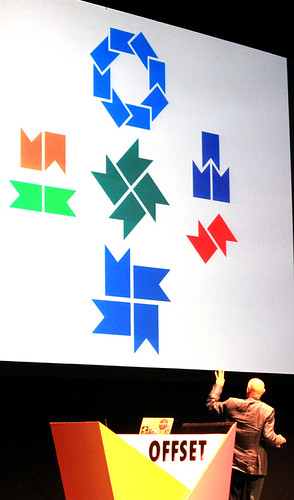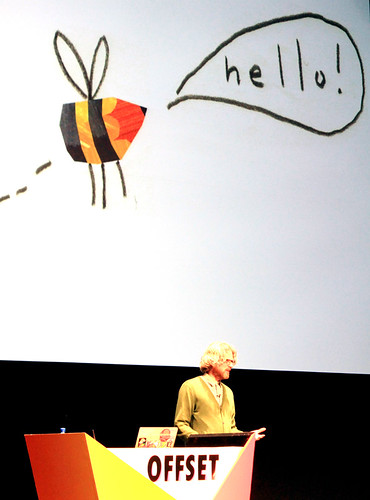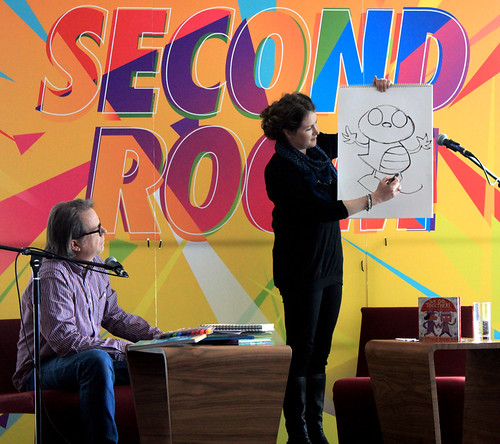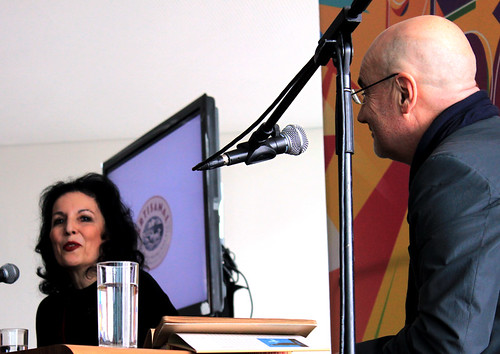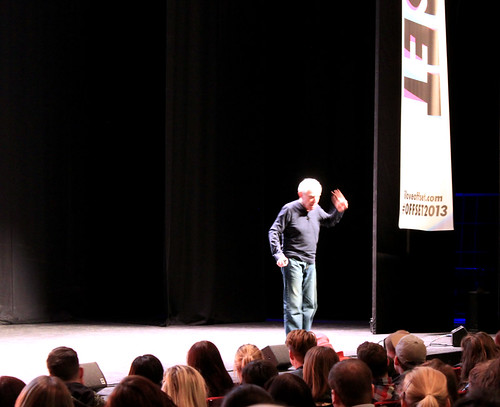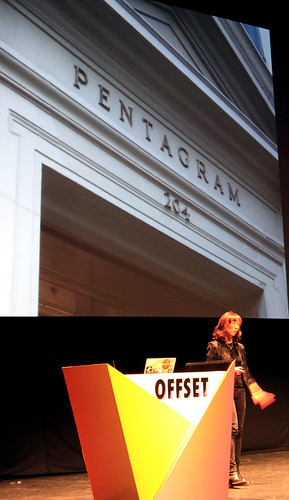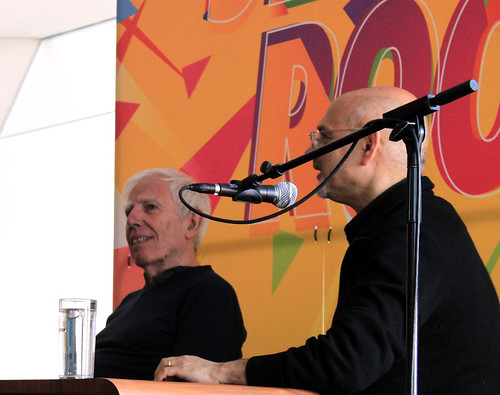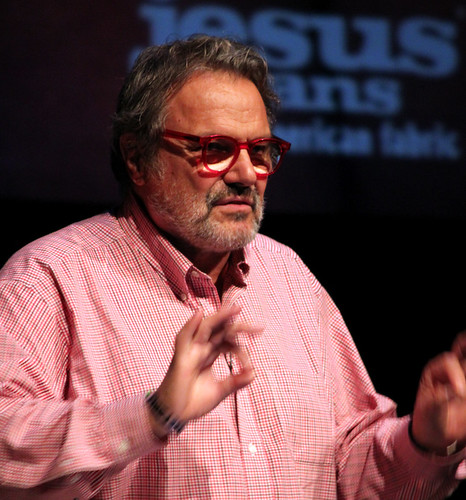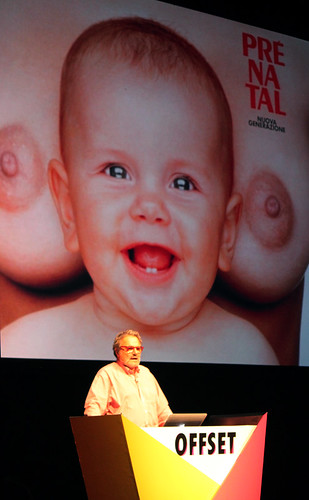Tuesday, 8:00am
9 April 2013
Offset 2013: day one
Bob Gill, Louise Fili and Ben Bos explain why design is ‘not a profession but a way of life.’ Pam Bowman reports from the Dublin conference.

Starting at 10am on Friday 5 April and finishing at 7pm the following Sunday, Offset 2013 had a demanding, exhausting programme, writes Pam Bowman. However it was hugely inspirational, with parties to boot!
The content was varied but some common themes arose: The DIY ethos: if it doesn’t exist, make it; if you don’t know it, learn it; and just do it because nobody is stopping you. Embrace failure. Take risks. Recognize opportunity. Balance ‘personal’ with ‘commercial’ work. Talk directly to niche audiences.
Ben Bos. Top: Jonathan McHugh.
Friday kicked off with Ben Bos (Total Design) and a list: ‘Looking, Seeing, Drawing, Writing, Photographing, Conceptual thinking, Designing.’
Bos talked of the importance of understanding a problem before designing. Another list included ‘Function (+)’, the necessary addition being emotion, because ‘without emotion it’s too cool.’
He declared: ‘Design is not a profession, it’s a way of life,’ and demonstrated this with a huge number of projects that spanned his extensive career. He showed corporate identity work, focusing on Randstad. He showed his posters, many for charitable causes, plus postage stamps, photography and what he calls ‘free work’, not work without fee, but without a brief.
‘The best tool we have is this (pointing to his head),’ he said. ‘Much better than the computers.’
Jonathan McHugh.
Next on the main stage was illustrator Jonathan McHugh. He explained the reasoning behind his alter ego Beepencil.com: ‘It’s something you can hide behind.’
The explained that the Northern Ireland attitude of ‘whatever you say, say nothing’ resonates with his role as an illustrator, communicating without words. He explained how he uses Photoshop to speed up his process with duplication of characters and application of textures, giving the work a crisper edge. And he talked about the importance of understanding how illustration work will be used – ‘You have to think of the context of the page’ – including the way the work is printed and displayed, and what other content might surround it.
Sharkey and Brown.
Louise Fili and Adrian Shaughnessy.
This was followed by New York designer Louise Fili (interviewed by Adrian Shaughnessy) with an honest and open discussion about her career path, dumb luck and good timing.
At Offset 2012 Jessica Hische, who had previously been a senior designer with Fili, spoke highly of her old boss. This year, the compliment was returned. She said: ‘I’m very proud of all my designers,’ whom she expects to move on and develop their careers – as she herself did after working for Herb Lubalin (and other studios).
Fili always works with two staff, a senior and junior designer and admits to being an ogre. She spoke of the importance of working with clients who are decision-makers – not ‘people second-guessing their boss’. This is one of the reasons why she likes working with smaller companies and start-ups. She also discussed the disappointment of having to remove work she likes from her website when the company does not survive – particularly common in the restaurant sector she works with so often.
Following the interview questions were taken from the audience, with a certain Mr Heller asking ‘Which is your favorite husband?’ Louise diplomatically avoided the question.
Bob Gill.
Back on the main stage, the very engaging Bob Gill showed few slides but talked dogmatically about ‘Design as idea’ and his process. ‘Every job is boring … the first thing I did was to make these boring problems interesting.’ He advised: ‘Have an opinion about something, and if the opinion is interesting so is the design,’ and if you ‘listen to the idea, it designs itself.’
He finished his presentation halfway through the hour-long slot and then kept the audience rapt by engaging the whole theatre in conversation. There are few performers who would be brave enough to do this but he pulled it off.
Natasha Jen, Pentagram.
Natasha Jen, a recent partner at Pentagram New York, talked about her work before joining the partnership and her first contact with them as an intern. She talked honestly about the worry she had about joining ‘The Empire’ and when she had joined, about the meagre number of small jobs she had in the first year. Lately, her workload has increased dramatically, and she has found her feet within the company.
Bob Gill and Steven Heller.
On the second stage, Bob Gill returned in conversation with Steven Heller, who asked him about Fletcher, Forbes, Gill – and how it began, and how it became so successful. ‘We had Swiss typography and American ideas and nobody could touch us,’ said Gill. ‘We ate everybody for breakfast!’
Heller asked ‘How come it stopped?’ Gill answered: ‘It never stopped, every year it added more partners. I just decided I didn’t want to be part of an empire although I dearly loved Fletcher and Forbes.’
Oliviero Toscani.
The last speaker of the day (on the main stage, with a full house) was photographer and creative director Oliviero Toscani, prolific in the world of and well known for his work for Benetton and Colors. His delivery and sense of comic timing was delightful (if not his timekeeping) and the audience was engaged throughout.
‘I’m still waiting for my calling, I don’t know what I want to do when I grow up,’ he said. His presentation was peppered a great chuckle, some serious stares and a multitude of one-liners:
‘I am a photographer, every day is a new experiment and every day I enjoy what I do!’
‘You don’t have to have ideas, be yourself, you are the idea!’
‘I like to photograph beautiful women and sometimes marry them!’
‘Go ahead, don’t be afraid of failing, it might help you.’
‘My wife knows that when I’m looking out of the window I’m working. She doesn’t bother me.’
‘What we call advertising is just communication’
As soon as there is photography there is history, documentary.’
‘Creativity can not be secure.’
Toscani’s statements were accompanied by stunning photography – a great end to day one.
More to come from Offset 2013 on subsequent Eye blog posts.
See our review of Outsider Insider Design of a Lifetime: Ben Bos in Eye 41 and our Reputations interview with Bob Gill in Eye 33.
Eye is the world’s most beautiful and collectable graphic design journal, published quarterly for professional designers, students and anyone interested in critical, informed writing about graphic design and visual culture. It is available from all good design bookshops and online at the Eye shop, where you can buy subscriptions and back issues.

